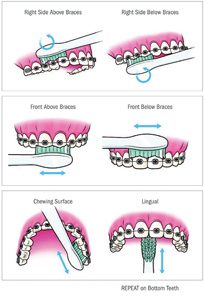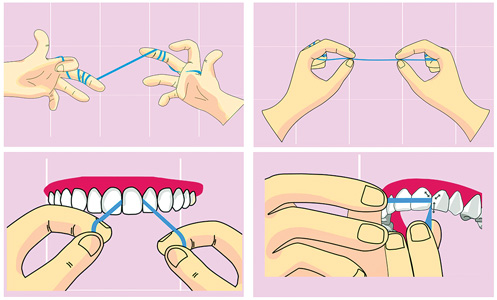Gums are an indicator of your health. Your gums and mouth could be the first indicator of various common health problems including disorders of the liver and theheart, Gastro-Esophagal Reflux Disease (GERD), ulcerative colitis, anaemiasetc. Studies suggest that pregnant women with poor oral hygiene are three times more likely to have premature, low birth weight babies.
How to keep our gums squeaky clean and healthy: Brush! Brush! Brush! Correct technique to brush:
- Take 3 teeth at a time, place toothbrush at a 45-degree angle against the gums (half the bristles should be on gums other half on tooth surface), move the brush back and forth in short strokes. Gently sweep the bristles from the gum towards the chewing surface. Brush outer surface, inner surface and chewing surface.
Recommended brushing time is two minutes in the morning and two minutes at night! If you have regular gums, use a medium bristle toothbrush; receding gums/swollen gums need soft toothbrush.
Avoid herbal toothpastes, use fluoridated toothpaste. - Change your toothbrush every three months or when you see it fray, whichever is earlier. Avoid keeping the toothbrush near the toilet as bacteria fly and wet toothbrushes are susceptible to harbouring them!
Electric toothbrushes are as effective as manual toothbrushes – what matters is HOW you brush. - If you wear braces, divide your teeth into 2 halves – one half between gums and brackets other half between edge of teeth and bracket. Place brush head between gums and braces and brush out debris. Do similarly for other half. Use interdental brush for areas between wire and teeth which cannot be reached with a normal toothbrush. Use a water floss with a special orthodontic attachment.
Flossing: Unlike brushing, flossing reaches between teeth and helps treat and prevent conditions like tooth decay, gingivitis and periodontal disease, which can lead to tooth loss. Gingivitis is an early and reversible form of periodontal or gum disease. It increases overall cleaning efficiency by 35 per cent.
The correct technique includes starting with about 18 inches of floss, wind most of the floss around each middle finger, leaving an inch or two of floss to work with. Holding the floss tautly between your thumbs and index fingers, slide it gently up-and-down between your teeth. Gently curve the floss around the base of each tooth, making sure you go beneath the gum line. Never snap or force the floss, as this may cut or bruise delicate gum tissue. Use clean sections of floss as you move from tooth to tooth. To remove the floss, use the same back-and-forth motion to bring the floss up and away from the teeth.
(Check out the conclusive part of Gum-Care in the next issue)
- Your Smile And You – Part-I - 4 July2016
- Preserve Those Teeth! - 28 June2016
- The Science Of Teeth: Gum Care – II - 22 June2016
